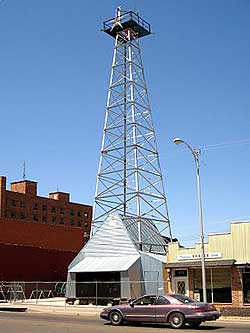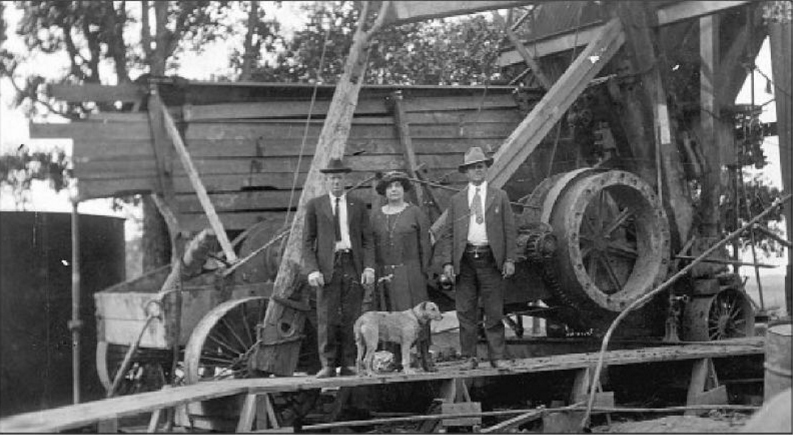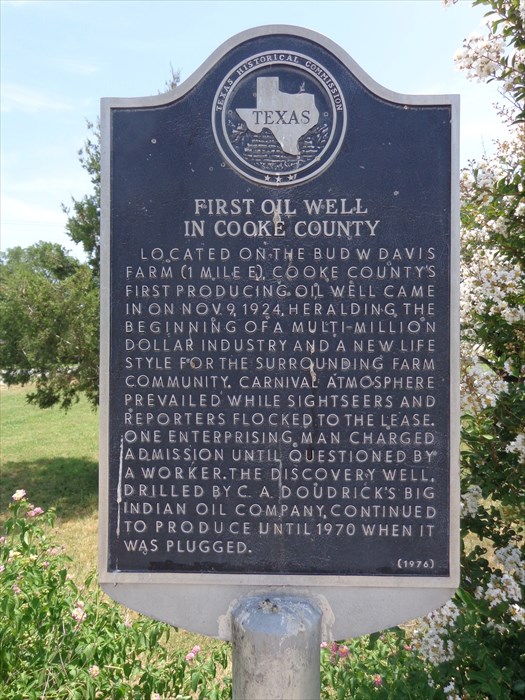by Bruce Wells | Feb 18, 2021 | Petroleum Pioneers
Remembering contributions of all petroleum industry pioneers.
The American Oil & Gas Historical Society (AOGHS), community museums, and professional associations have sought ways to preserve written histories of the men and women who have worked in the industry. Many museum have established oral (and video) history collections.
Sharing Your Story
AOGHS offers an outreach resource for those wanting to share their career experiences in the petroleum industry. When contacted with family stories, the historical society tries to post some of the personal oilfield stories of women, including oilfield crew leader Tamara George.
Helping add to this chronicle of oilfield women pioneers, a 2020 email from the son of Lynda Armstrong noted her working as a roustabout for Gulf Oil in 1974.
Lynda Armstrong: Gulf Oil Roustabout
Although Tamara George’s pioneering work as a roustabout foreman was notable, other determined women made similar pioneering oilfield achievements (see Women of the Offshore Petroleum Industry tell Their Stories). In August 2020, John Armstrong emailed the historical about his late mother’s accomplishments. He reported that In 1974, Lynda Armstrong worked in Goldsmith Texas, outside of Odessa, “as a roustabout for Gulf Oil before becoming the foreman for the water injection plant that is located on the Y.T .Ranch in Goldsmith.”

“I blazed a few trails in my days,” noted the late Lynn Armstrong about her oilfield career.
Armstrong would go on to teach corrosion technology at Odessa College and Eastern New Mexico University. “I blazed a few trails in my days,” she later explained about her oil patch career: “Gulf Oil, first woman to be hired in 1974 as roustabout; Arco lease operator; Enserch production supervisor; ENMU-R production technology instructor; Odessa College technology instructor.”
Tamara George: Roustabout Crew Leader
In early 1980s in Texas Panhandle oilfields, Tamara L. George led a skilled service company crew. Among the very first women to hold the dangerous, labor-intensive job, her oilfield journey began at D-J’s Roustabout and Well Services in Borger, Texas. “At the time two brothers owned the company, Jerry Nolan, who handled the office work, and Harold Nolan, who did everything outside the office, George explained in a December 2018 email to AOGHS.
“It was Harold Nolan who wanted to hire me, but Don Nolan was not keen on this idea thinking I would be problems that I could not handle the work, get along with the men,” she added. “Don did not know I had been an Industrial, commercial and residential electrician, apprentice iron welder, and an auto body technician.”

The Hutchinson County Historical Museum in Borger exhibits North Texas petroleum heritage with emphasis on the oilfield boom of the 1920-1930 era. Photo by Bruce Wells.
She said Nolans gave her a chance, and “within six months I moved to being a roustabout foreman running my own crew,” George explained in her note to the historical society. “I was the most requested crew in the Texas Panhandle oilfields.”
After leading her crews in the 1980s, George has proclaimed herself to be “only woman to ever hold such a position,” and even the “first woman to be a roustabout foreman in oilfield history!” Her personal oilfield record (which she is still researching) may extend to Canada, where she worked a few months as a roustabout foreman for Pangea Oil & Gas Company of Calgary, Alberta. And there’s still more to her career firsts. “When the oilfield shut down, I went into medicine,” she noted, adding that she returned to school to work on advanced degrees in radiology and gastroenterology. Then came a personal health crisis.
“I was around two years into obtaining my doctorates when a fatal tumor revealed itself,” George explained. “The tumor had caused a rather large aneurysm to which the doctors shook their heads in disbelief.” It was a mystery to her doctors how the roustabout foreman survived while doing such labor intensive work of the oil industry. In the years since her service company work, George, who today lives in Elk City, Oklahoma, has “not come across any women doing what I did” earlier in the oilfields.
Oil History of Borger, Texas
Thousands of people rushed to the Texas Panhandle in early 1926 after Dixon Creek Oil and Refining Company completed the Smith No. 1 well, which flowed at 10,000 barrels of oil a day in southern Hutchinson County. A.P. “Ace” Borger of Tulsa, Oklahoma, leased a 240-acre tract and by September his Borger oilfield had more than 800 producing wells, yielding 165,000 barrels a day Dedicated in 1977, the Hutchinson County Boom Town Museum in Borger today celebrates “Oil Boom Heritage” every March. Special exhibits, events and school tours occur throughout the Borger celebration, about 40 miles northeast of Amarillo.
______________________
Recommended Reading: Breaking the Gas Ceiling: Women in the Offshore Oil and Gas Industry (2019); Anomalies, Pioneering Women in Petroleum Geology, 1917-2017 (2017). Your Amazon purchase benefits the American Oil & Gas Historical Society. As an Amazon Associate, AOGHS earns a commission from qualifying purchases.
______________________
The American Oil & Gas Historical Society preserves U.S. petroleum history. Become an AOGHS supporting member and help maintain this energy education website and expand historical research. For more information, contact bawells@aoghs.org. Copyright © 2021 Bruce A. Wells. All rights reserved.
Citation Information – Article Title: “Women Oilfield Roustabouts.” Author: Aoghs.org Editors. Website Name: American Oil & Gas Historical Society. URL: https://aoghs.org/petroleum-pioneers/women-oilfield-roustabouts. Last Updated: April 30, 2021. Original Published Date: December 6, 2018.
by Bruce Wells | May 17, 2016 | Petroleum Companies
Irene Hathaway sold encyclopedias door to door before taking a chance in Texas with the Big Indian Oil & Development Company and becoming a woman wildcatter.

Irene Hathaway stands with two unidentified men at the first oil well in Cooke County, Texas, in 1924. Photo courtesy F.W. Blagg, Morton Museum of Cooke County.
Drilling for petroleum in unexplored regions – wildcatting – began with the first American oil well in 1859.
Over the years and despite advances in drilling technologies and the science of geology, nine out of 10 wildcat wells would be dry holes.
Despite the risk, thousands of companies and investors took the expensive gamble and drilled exploratory wells. A few of these wildcatters became legendary, but most were soon forgotten. They almost always were men. Almost always.
Irene Hathaway decided to become a Texas wildcatter while visiting a small town in 1918. She was a single woman in her 50s from Kansas City, Missouri, who went to Texas to peddle encyclopedias. She came across the tiny hamlet of Callisburg, populated by about 100 hardy farming souls. After hearing rumors of “huge untapped reservoirs of oil,” she began searching for anyone who would gamble on a lease.
“One of my favorite stories of Cooke County is that of wildcatter Ms. Irene Hathaway,” notes Jayleane Mays Smith, director of the Morton Museum in Gainesville, who researched the oil-patch business woman. She found that Hathaway had begun leasing land in 1919 near Callisburg in northeastern Cooke County.
In 1922 the encyclopedia saleswoman convinced representatives of the Big Indian Oil & Development Company to drill two miles east of Callisburg. She also convinced farmer Bud W. Davis to lease his land for drilling, “which at that time was sheer speculation,” Mays Smith notes in a 2014 article.
Drilling started at 6:30 p.m. on Tuesday, August 15, 1922, reported the Gainesville Daily Register. “The machinery and the bit began boring into the earth. The vibration could be felt over a wide area.”
Hathaway took up residence in Gainsville, just a few miles from the well. She visited often as drilling continued month after month – for two years.
“The company was ready to abandon the location, but Irene was convinced oil was there,” Mays Smith reports. “She strongly encouraged them to continue drilling just a little while longer, even making them an offer to pay the workers with money from her own pocket.”
On November 9, 1924, Big Indian Oil & Development brought in an oil gusher from 3,535 feet deep. Mays Smith says the Davis family reportedly was seated at the kitchen table, “leisurely enjoying a Sunday dinner when their 16-year-old son, Ray, looked out the window and shouted, ‘The well’s blowin’! Let’s run down and see it!'”
Mays Smith further reports that Bud Davis calmly said, “‘Eat your dinner, son. They’ll take care of that well ‘til we get through eatin. ‘”
News of the wildcat discovery spread quickly. Within days more 5,000 spectators had come to watch the company tame its No. 1 Davis well. Lease prices skyrocketed for miles around as oil fever spread.
“I believe this story lives on because people were fascinated not only by the drilling process, but also by Ms. Hathaway and her vision,” concludes Mays Smith.
Irene Hathaway was 80 when she died in 1949 in Gainesville – without great wealth, but with a story that survives in the Bob Bullock Museum Texas Story Project, Ms. Irene Hathaway, Wildcatter. In 2012 Cooke County oil revenues reached more than $575 million.
Today, a Texas Historical Commission marker commemorates Cooke County’s first oil-producing well, noting a “carnival atmosphere prevailed while sightseers and reporters flocked to the lease. One enterprising man charged admission until questioned by a worker.”
Big Indian Oil & Development Company

A 1976 Texas Historical Commission marker documented Cooke Country’s first oil well of 1924.
Big Indian Oil & Development had been formed in Kansas City, Kansas, on April 8, 1920, with C.A. Doudrick as president and Harry Doudrick as secretary-treasurer. Stock sales were key to financing the company and promising oil prospects like Hathaway’s were key to its success – and survival.
Although the Cooke County 1924 well settled into producing just 10 barrels of oil a day, production would last until 1970. Interviewed in 1979, land owner Bud Davis remembered the feverish investing caused the county’s first oil well:
“It caused a lot of money to be spent there because people come in there and bought acreage…some of them eight to ten miles away,” he said. “They didn’t know where that oil went to and they was just so anxious to get a little interest in some oil there they just buy whatever they could buy.”
Only a month after completing the No. 1 Davis well, Big Indian Oil & Development sold it and other suddenly valuable holdings near Callisburg. The company wanted to finance further drilling using more advanced rotary technology.

This January 1935 Big Indian Oil & Development Company newsletter to investors was among the last.
By June 16, 1926, a Sherman, Texas, newspaper noted Big Indian Oil & Development had signed two year extensions on several leases with Vacuum Oil Company, a subsidiary of Standard Oil. It also was announced the company (now with offices in Gainsville) had received an offer to expand exploration efforts into Mexico.
However, the company struggled during the Great Depression and with production from the giant East Texas oilfield lowering oil prices. One of the last company newsletters advised shareholders in January 1935: “The industry thus approaches the new year with courage and with hope. It has experienced a year marred to some extent by hot oil and price wars…”
Big Indian Oil had completed its Cooke County well when Texas oil sold for $1.52 a barrel. The East Texas oilfield soon produced more than 216 million barrels of oil, driving prices even lower. When prices reached 94 cents per barrel in 1935, Big Indian Oil & Development did not survive.
Legendary Oilmen & Women
Oilmen like Thomas Slick became famous when they beat the odds and struck oil. Once known as Dry Hole Slick, in 1922 he discovered the giant Cushing oilfield and became known as Oklahoma’s King of the Wildcatters. By 1929 his net worth was between $35 million and $100 million.
But Slick was the exception in the high-risk U.S. oil patch, where far more exploration ventures struggled by or went bankrupt. With investors and speculators paying the bills in this male dominated industry, it took determined women like Irene Hathaway to succeed. Earlier there was Mrs. Byron Alford.
During the industry’s earliest days in Pennsylvania, Alford was the “Only Woman in the World who Owns and Operates a Dynamite Factory,” proclaimed a Bradford newspaper in 1899. As owner of Mrs. Alford’s Nitro Factory, she was an astute businesswoman in the midst of America’s first billion dollar oilfield, which in 1881 supplied 77 percent of the world’s oil.
Another example is a former piano teacher who gained control of the Los Angeles oilfield – and for decades was known as the California Oil Queen. Emma Summers’ first Los Angeles well was drilled about a mile west of today’s Dodger Stadium.
“I saw a chance in the oil business and sunk a well, and that carried me on and on until I couldn’t stop,” she later explained. Her wells produced 50,000 barrels a month.
At first she sold her oil through local brokers, but eventually took on that challenge in addition to managing her supplies, 40 horses, 10 wagons and a blacksmith shop. “There are men in Los Angeles who do not like Emma A. Summers,” noted a 1911 issue of Sunset magazine as her petroleum interests grew.
Summers, who died in a Glendale nursing home in 1941 at age 83, had a “genius for affairs.” Her control of Los Angeles oilfields earned the former piano teacher her title.
___________________________________________________________________________________
The stories of other exploration attempts to join petroleum exploration booms (and avoid busts) can be found in an updated series of research at Is my Old Oil Stock worth Anything?
Please support the American Oil & Gas Historical Society and this website with a donation. © AOGHS.






